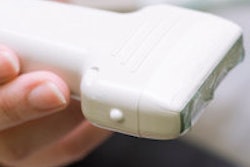Thursday, December 5 | 10:30 a.m.-10:40 a.m. | SSQ05-01 | Room N226
Ultrasound reliably predicts appendicitis if secondary characteristics are assessed when the appendix is of borderline size, defined as 6 mm to 7 mm in diameter, according to a study to be presented in this Thursday RSNA 2013 session.Dr. Brooke Jeffrey, from Stanford University, and colleagues investigated whether secondary findings on ultrasound such as hyperemia and hyperechoic fat could help clinicians diagnose patients whose appendices were considered borderline for appendicitis by size criteria.
The group reviewed 3,506 ultrasound examinations for suspected appendicitis in patients who presented to the emergency department between 2007 and 2012. Three radiologists blinded to the patients' final diagnoses identified 98 sonograms with appendices that were noncompressible and 6 mm to 7 mm in diameter; the radiologists evaluated them for secondary findings of appendicitis such as hyperemia, hyperechoic fat, loss of the submucosal layer echo, periappendiceal fluid, and appendicoliths.
Of the 98 borderline sonograms, 52% were shown to be appendicitis on surgical pathologic examination, the team found. Of the secondary signs, hyperechoic fat had the highest individual positive predictive value (78%) and specificity (83%) for appendicitis, and these increased to 80% and 89%, respectively, when hyperemia also was present.
Without secondary signs, clinicians should take a conservative approach to treating patients with borderline appendices, the researchers cautioned.




















